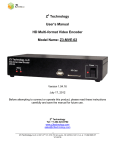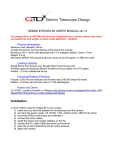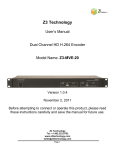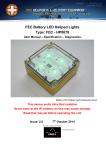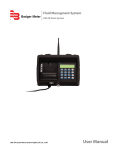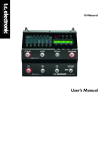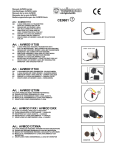Download Rapid Deployment GSM/GPS Tracking Unit (RDT) End User Manual
Transcript
Rapid Deployment GSM/GPS Tracking Unit (RDT) End User Manual Specifications subject to change without notice. GSM coverage required. Vital Trace is not responsible for the operation or failure of operation of GPS satellites or the availability of GPS satellite signals or the operation or failure of operation GSM network and GSM network signal strength. Confidential Page 1 9/7/05 Index Hardware Limited Warranty .....................................................................................................3 Warranty Exclusions and Disclaimer ........................................................................................3 Limitation of Liability ...............................................................................................................3 Regulatory Approvals...............................................................................................................4 Overview..................................................................................................................................4 Diagnostics ..............................................................................................................................5 User Guidelines ........................................................................................................................5 Placement and Orientation.......................................................................................................5 Introduction.............................................................................................................................7 Planning and Preparation.........................................................................................................7 Deployment/attachment..........................................................................................................7 Power pack change/retrieval ...................................................................................................7 Specifications subject to change without notice. GSM coverage required. Vital Trace is not responsible for the operation or failure of operation of GPS satellites or the availability of GPS satellite signals or the operation or failure of operation GSM network and GSM network signal strength. Confidential Page 2 9/7/05 US Patents 5877724, 6122506 and 6430503 apply. Hardware Limited Warranty Vital Trace warrants that this Vital Trace hardware product (the “Product”) shall be free from defects in materials and workmanship and will substantially conform to Vital Trace’s applicable published specifications for the Product for a period of one (1) year, starting from the date of delivery. The warranty set forth in this paragraph shall not apply to software/firmware products. Software and Firmware Limited Warranty License This Vital Trace software and/or firmware product (the “Software”) is licensed and not sold. Its use is governed by the provisions of the applicable End User License Agreement (“EULA”), if any, included with the Software. In the absence of a separate EULA included with the Software providing different limited warranty terms, exclusions, and limitations, the following terms and conditions shall apply. Vital Trace warrants that this Vital Trace Software product will substantially conform to Vital Trace’s applicable published specifications for the Software for a period of ninety (90) days, starting from the date of delivery. Warranty Remedies Vital Trace's sole liability and your exclusive remedy under the warranties set forth above shall be, at Vital Trace’s option, to repair or replace any Product or Software that fails to conform to such warranty (“Nonconforming Product”), or refund the purchase price paid by you for any such Nonconforming Product, upon your return of any Nonconforming Product to Vital Trace in accordance with Vital Trace’s standard return material authorization procedures. Warranty Exclusions and Disclaimer These warranties shall be applied only in the event and to the extent that: (i) the Products and Software are properly and correctly installed, configured, interfaced, maintained, stored, and operated in accordance with Vital Trace's relevant operator's manual and specifications, and; (ii) the Products and Software are not modified or misused. The preceding warranties shall not apply to, and Vital Trace shall not be responsible for defects or performance problems resulting from (i) The combination or utilization of the Product or Software with products, information, data, systems or devices not made, supplied or specified by Vital Trace; (ii) The operation of the Product or Software under any specification other than, or in addition to, Vital Trace's standard specifications for its products; (iii) The unauthorized modification or use of the Product or Software; (iv) Damage caused by accident, lightning or other electrical discharge, fresh or salt water immersion or spray; or (v) Normal wear and tear on consumable parts (e.g., batteries). THE WARRANTIES ABOVE STATE VITAL TRACE'S ENTIRE LIABILITY, AND YOUR EXCLUSIVE REMEDIES, RELATING TO PERFORMANCE OF THE PRODUCTS AND SOFTWARE. EXCEPT AS OTHERWISE EXPRESSLY PROVIDED HEREIN, THE PRODUCTS, SOFTWARE, AND ACCOMPANYING DOCUMENTATION AND MATERIALS ARE PROVIDED “AS-IS” AND WITHOUT EXPRESS OR IMPLIED WARRANTY OF ANY KIND BY EITHER VITAL TRACE NAVIGATION LIMITED OR ANYONE WHO HAS BEEN INVOLVED IN ITS CREATION, PRODUCTION, INSTALLATION, OR DISTRIBUTION INCLUDING, BUT NOT LIMITED TO, THE IMPLIED WARRANTIES OF MERCHANTABILITY AND FITNESS FOR A PARTICULAR PURPOSE, TITLE, AND NONINFRINGEMENT. THE STATED EXPRESS WARRANTIES ARE IN LIEU OF ALL OBLIGATIONS OR LIABILITIES ON THE PART OF VITAL TRACE ARISING OUT OF, OR IN CONNECTION WITH, ANY PRODUCTS OR SOFTWARE. SOME STATES AND JURISDICTIONS DO NOT ALLOW LIMITATIONS ON DURATION OR THE EXCLUSION OF AN IMPLIED WARRANTY, SOTHE ABOVE LIMITATION MAY NOT APPLY TO YOU: VITAL TRACE IS NOT RESPONSIBLE FOR THE OPERATION OR FAILURE OF OPERATION OF GPS SATELLITES OR THE AVAILABILITY OF GPS SATELLITE SIGNALS. Limitation of Liability VITAL TRACE ENTIRE LIABILITY UNDER ANY PROVISION HEREIN SHALL BE LIMITED TO THE GREATER OF THE AMOUNT PAID BY YOU FOR THE PRODUCT OR SOFTWARE LICENSE OR U.S $25.00. TO THE MAXIMUM EXTENT PERMITTED BY APPLICABLE LAW, IN NO EVENT SHALL VITAL TRACE OR ITS SUPPLIERS BE LIABLE FOR ANY INDIRECT SPECIAL INCIDENTAL OR CONSEQUENTIAL DAMAGES WHATSOEVER UNDER ANY CIRCUMSTANCE OR LEGAL THEORY RELATING IN ANY WAY TO THE PRODUCTS SOFTWARE AND ACCOMPANYING DOCUMENTATION AND MATERIALS (INCLUDING, WITHOUT LIMITATION, DAMAGES FOR LOSS OF BUSINESS PROFITS, BUSINESS INTERRUPTION, LOSS OF BUSINESS INFORMATION, OR ANY OTHER PECUNIARY LOSS), REGARDLESS WHETHER VITAL TRACE HAS BEEN ADVISED OF THE POSSIBILITY OF ANY SUCH LOSS AND REGARDLESS OF THE COURSE OF DEALING WHICH DEVELOPS OR HAS DEVELOPED BETWEEN YOU AND VITAL TRACE. BECAUSE SOME STATES AND JURISDICTIONS DO NOT ALLOW THE EXCLUSION OR LIMITATION OF LIABILITY FOR CONSEQUENTIAL OR INCIDENTAL DAMAGES, THE ABOVE LIMITATION MAY NOT APPLY TO YOU Notices Class B Statement – Notice to Users: This equipment has been tested and found to comply with the limits for a Class B digital device, pursuant to Part 15 of the FCC rules. These limits are designed to provide reasonable protection against harmful interference in a residential installation. This equipment generates, uses, and can radiate radio frequency energy and, if not installed and used in accordance with the instructions, may cause harmful interference to radio communication. However, there is no guarantee that interference will not occur in a particular installation. If this equipment does cause harmful interference to radio or television reception, which can be determined by turning the equipment off and on, the user is encouraged to try to correct the interference by one or more of the following measures: –Reorient or relocate the receiving antenna. –Increase the separation between the equipment and the receiver. –Connect the equipment into an outlet on a circuit different from that to which the receiver is connected. –Consult the dealer or an experienced radio/TV technician for help. Changes and modifications not expressly approved by the manufacturer or registrant of this equipment can void your authority to operate this equipment under Federal Communications Specifications subject to change without notice. GSM coverage required. Vital Trace is not responsible for the operation or failure of operation of GPS satellites or the availability of GPS satellite signals or the operation or failure of operation GSM network and GSM network signal strength. Confidential Page 3 9/7/05 Regulatory Approvals CE The RDT product complies with the essential requirements of the R&TTE Directive 199/5/EC as stated by the EC Declaration of Conformity (CE0681) and the EC R&TTE Type Examination Certificate. The RDT product complies with the European Telecommunications Standards Institute Specifications ETS300-342-1 (EMC for GSM 900MHZ and DCS 1800MHZ Radio Equipment and Systems). EEC The RDT product complies with Directive 72/245/EEC as amended by Directive 95/54/EC (el*72/245*95/54). FCC The RDT product complies with the FCC Part 15, FCC Part 24, and Industry Canada requirements. The RDT product complies with Part 15 of the FCC rules. Operation is subject to the following two conditions: (1) This device may not cause harmful interference, and (2) This device must accept any interference received, including interference that may cause undesired operation. FCC ID: JUPRDT1. Overview Introduction This manual covers the RDT operating on 900 MHz, 1800 MHz and 1900 MHz GSM networks. As used in this manual, the term GSM shall include any and all of these frequencies. Regulatory Approvals CE The RDT product complies with the essential requirements of the R&TTE Directive 199/5/EC as stated by the EC Declaration of Conformity (CE0681) and the EC R&TTE Type Examination Certificate. The RDT product complies with the European Telecommunications Standards Institute Specifications ETS300-342-1 (EMC for GSM 900MHZ and DCS 1800MHZ Radio Equipment and Systems). EEC The RDT product complies with Directive 72/245/EEC as amended by Directive 95/54/EC (el*72/245*95/54). 1.1.2 FCC The RDT product complies with FCC Part 15, FCC Part 24, and Industry Canada requirements. The RDT product complies with Part 15 of the FCC rules. Operation is subject to the following two conditions: (1)This device may not cause harmful interference, and (2)This device must accept any interference received, including interference that may cause undesired operation. RDT The RDT is housed in a single, compact enclosure that simplifies installation and leads to greater reliability. The standard RDT has four end-user replaceable alkaline AA batteries and there are no external antennas other external connections. This package is a mobile communications and positioning system module ideally suited for high volume automotive and asset management applications requiring a low-cost, battery or externally powered tracking device. It operates over the GSM cellular networks and allows simple, fast, and efficient transfer of information between a mobile asset and an application hosted either on a server or on an end-user PC. Standard Features The RDT integrates the following into a single package: GSM 900/1800/1900 MHz modem High-sensitivity, 12-channel GPS receiver Internal GSM and GPS antennas RDT application firmware and other integrated functions Password-protected data communications Subscriber Identity Module (SIM) You must install a SMS-enabled Subscriber Identity Module (SIM) that has been initialized by your GSM service provider. Global System for Mobile Communications Cellular mobile telephone systems are widely available throughout the world. However, because cellular mobile telephone systems are regulated at the national level, these systems are not generally compatible with each other. To resolve the dilemma of being able to communicate from almost anywhere, but only within your own system, the European telecommunications operators—the Conference of European Postal and Telecommunications Administration (CEPT)—designed a new mobile telephone network. This network has evolved into GSM, and CEPT has turned over management of GSM to the European Technical Standards Institute (ETSI). GSM is the predominant mobile communications system throughout the world. Outside the United States, most GSM systems operate at 900 MHz, 1800 MHz or both and services provided by these networks are generally referred to as Digital Communication Services (DCS). The United States GSM system operates at 1900 MHz and is generally referred to as Personal Communication Service (PCS). GSM Cellular Phone System The Global System for Mobile (GSM) protocol offers a variety of data services that allow users to send and receive data at rates of up to 9600 bps. Data can be delivered over ISDN, Packet Switched or Circuit Switched Data Networks (PSDN or CSDN) and via the Short Message Service (SMS). The RDT uses SMS, which is a store-and-forward service for the bidirectional exchange of alphanumeric messages of up to 160 characters. Architecture of the GSM network Any asset tracking or management system on GSM consists of several distinct components. The RDT is the mobile unit that is installed in the vehicle, equipment or other mobile asset and contains the Subscriber Identity Module (SIM). The SIM card contains a unique International Mobile Subscriber Identity (IMSI) number. This enables the network to identify the user and therefore allow the terminal to have access to specific, subscriber services. Global Positioning System The Global Positioning System (GPS) is a satellite-based navigation system operated and maintained by the U.S. Department of Defence. GPS consists of a constellation of 24 satellites providing worldwide, 24-hour, three-dimensional (3D) coverage. Although originally conceived for military needs, GPS has a broad array of civilian applications including timing, surveying, fleet management, marine, land, aviation, and vehicle navigation. GPS is the most accurate technology available for navigation. As a satellite-based Specifications subject to change without notice. GSM coverage required. Vital Trace is not responsible for the operation or failure of operation of GPS satellites or the availability of GPS satellite signals or the operation or failure of operation GSM network and GSM network signal strength. Confidential Page 4 9/7/05 system, GPS is immune from the limitations of land-based systems, which have limited coverage and whose accuracy varies with geographic location and, even under ideal conditions, cannot compare with GPS. By computing the distance to GPS satellites orbiting the earth, a GPS receiver can calculate an accurate position. This process is called satellite ranging. GPS receivers can also provide precise time, speed, and course measurements that are important for vehicle mobile positioning and communications applications. GPS Receiver The RDT includes an advanced GPS receiver, which provides the position, course, speed and time information required for mobile asset management applications. The RDT’s GPS receiver features a twelve-channel digital signal processor (DSP) which operates at the GPS L1 frequency (1575.42 MHz) and processes the Coarse/Acquisition (C/A) code portion of the GPS signal. The RF and digital signal processing components of the GPS module are custom ASICs designed by Trimble. Diagnostics When the Diagnostics Mode is enabled and set to 1 (LED) the LED on the RDT will blink at different rates depending on the RDT’s operational state. If the RDT is powered off the LED is off. If the estimated battery life is below the threshold of 10% the LED is turned on continuously while the RDT is operational and not blinked. Only if the batteries are good will the blinking rates in Table 1 apply. RDT State IDLE Blink Rate 250ms ON / 250 ms OFF FIX DELAY 2000ms ON / 2000 ms OFF 200ms ON / 1800ms 1800ms ON / 200ms Always OFF DELAY to IDLE One 2000ms ON TRANSMIT QUERY Always ON Plain Words Rapid blinking or while in On Demand Polling Mode Long On, Long Off OFF Short Blinks OFF Long On, very short off time Unit powers Off in Delay state One blink as unit transitions from DELAY to IDLE state Low Battery Table 1, Diagnostic LED Blink Rates User Guidelines Introduction The RDT is a completely self-contained end-user device. As such no specific installation is required. There are no external connections required for antennas or power when used in its standard battery-powered configuration. Like all GPS and wireless devices, the RDT will work best where it can have a relatively unobstructed view of the sky and wireless base station antenna. Nonetheless, the RDT employs advanced GPS technology that increases its ability to acquire weak GPS signals. This allows the device to be deployed in environments where traditional GPS receivers may not be able to determine location. General Guidelines Initial Use after Provisioning: The RDT comes from the factory without current time being set and without GPS almanac or location stored in memory. As a consequence, it is important that when the RDT is first activated that it be given sufficient time to calculate its first position fix and to collect a complete GPS almanac. After the RDT has been configured per the instruction provided in the RDT Configuration chapter, it is recommended that the RDT be powered up, using either batteries, and the unit remaining stationary with a clear, unobstructed view of the sky. This will allow the RDT to calculate a position fix in the shortest possible time and allow it to collect a GPS almanac. During this first session, the RDT may take up to fifteen (15) minutes beyond the expiration of FIX Timeout, before sending the next SMS message. Placement and Orientation Generally, the RDT will perform best when used as close as possible to horizontal plane, preferably with reasonably unobstructed clearance around the unit. Field tests indicate that the RDT performs reasonably well when placed in the glove box or under the front passenger seat in many contemporary automobiles. It should not be installed in the boot of a vehicle unless it can be placed near or under the rear window parcel shelf. Try to avoid placing the unit where its view of the sky is obstructed by metal or surfaces coated with metallic paint or films. Field data indicates that a RDT placed in the glove box of a vehicle will get approximately 50% fewer position fixes than an identically configured unit placed on the dashboard with a clear view of the sky. Actual results will vary from vehicle to vehicle and based on the level of obstruction outside the vehicle itself. Another important consideration is that battery life will be shorter for units placed in obscured locations since it will take longer to compute new position fixes. Units with a clear view of the sky will typically take 40-50 seconds to compute a new position fix as shown in below. If the GPS signal level drops to –136 dBm due to obscuration, then the time to compute typically increases to over 6 minutes. During this additional time, the unit is powered up and battery life will decrease accordingly . Specifications subject to change without notice. GSM coverage required. Vital Trace is not responsible for the operation or failure of operation of GPS satellites or the availability of GPS satellite signals or the operation or failure of operation GSM network and GSM network signal strength. Confidential Page 5 9/7/05 Placement vs. Reporting Frequency Specifications subject to change without notice. GSM coverage required. Vital Trace is not responsible for the operation or failure of operation of GPS satellites or the availability of GPS satellite signals or the operation or failure of operation GSM network and GSM network signal strength. Confidential Page 6 9/7/05 Fix Times capacity, planned. Standard Operating Procedures (Sop’s) for the deployment of the RDT Introduction The RDT is used as a quick deployment-tracking device, used in conjunction with the VITAL TRACK software. To enhance the chances of an operational success and minimise a compromise, the following basic procedures should be followed to enable the operator(s) to achieve best practice when working with the RDT in a covert manner. Planning and Preparation • On no account must the RDT be given to anyone who has not received prior training from Vital Trace. • Always ensure that the RDT has a simm card fitted, which is not easily traceable (advice through Vital Trace) and the batteries are new. • Program the VITAL TRACK software with the correct information required to communicate with the RDT. • Carry out an attachment/detachment, on the same make and model that your target vehicle is going to be. This activity allows the deployment team to find the most suitable position for concealment and a GPS signal. It also reduces the time on target. • A day and night reconnaissance of the area and location that the target vehicle is expected to be, should be carried out prior to any deployment. • Although one operator can carry out the deployment/attachment of the RDT, it is recommended that at least two (2) operators be used or more, depending on the tactical circumstances. • Each member of the deployment team should be thoroughly briefed and understand each contingency plan prior to deployment. • When an alarm signal is received indicating that the RDT is operating at 30% battery a battery replacement must be Deployment/attachment • Where possible, deployment of the RDT should take place during the hours of darkness (silent hours). • Drive/walk past the target vehicle or pre-deploy cover/observation if necessary before deployment. • At least five (5) minutes before deployment attach the battery power pack to the RDT, ensure that it is place in a position to allow the unit to obtain a GPS position fix. This procedure should be done from a static position away from the target area. Note: On account will the RDT be deployed until a position fix has been acquired. • All members of the deployment team should have communication with each other. • Approach the target with caution and attach the RDT squarely, ensuring that all magnets have contact, it is well concealed and a new position fix is obtained. • When both the VITAL TRACK software and the RDT are communicating with an acceptable position fix, record the attached position by use of a small digital camera if necessary. Before withdrawing, make sure that no tell tale signs are evident in the immediate vicinity of the target vehicle. • When any technical operations of this nature are carried out, there should always be a conventional surveillance team deployed to cover actions on such as, a compromise, technical problems, power pack changes and retrieval of equipment post Op. Power pack change/retrieval All battery changes or complete retrieval of the RDT from the target vehicle should be planned and approached in the same manner as the initial deployment/attachment. Specifications subject to change without notice. GSM coverage required. Vital Trace is not responsible for the operation or failure of operation of GPS satellites or the availability of GPS satellite signals or the operation or failure of operation GSM network and GSM network signal strength. Confidential Page 7 9/7/05 • • If a different team is deployed to carry out a battery change or retrieval, they must be fully briefed on the situation and know exactly where the RDT is positioned on the target vehicle. Points to note • • • • • • • • The GPS antenna cannot obtain a position fix when shielded by a metal surface. Therefore it is important that when attaching the unit to the intended target it is placed behind a non ferrous surface e.g. behind the front or rear plastic bumpers or in the areas close to light clusters. It must not be immediately visible if a quick underneath inspection of the vehicle is carried out. The unit can be placed horizontal or vertical without loosing attenuation depending on the space available. Always ensure that the unit has new batteries inserted (Trim Track) before being deployed. If the unit is placed onto the intended target in a confined or enclosed location (garage). Then the acquisition time for the GPS is going to increase. To reduce acquisition time it is important that the unit is placed on the intended target out in the open. Where possible always recce the intended target and carry out best placement practice on the same type of vehicle. Remember that if the target vehicle goes into tunnels – underground car parks – enclosed garages – or anywhere that will block the sky. The GPS will always give its last known position before it went unsighted, until it becomes visible again to the sky; where it will re-acquire and give its real time position. If GSM coverage is inhibited then as soon as the unit becomes communicable again it will send any messages owed via SMS. RF Jamming The RDT should be installed as far away as possible from transmitting antennas, including satellite communication, radar, VHF and cellular. These transmitters may emit jamming signals that interfere with the GPS receiver’s ability to track GPS satellite signals. Generally, the stronger the other transmitting device, the wider the distance required between antennas. For the RDT, a minimum clearance of 45 cm (approximately 18 in.) from these transmitting devices, including other RDTs, is recommended. Mounting Optional mounting brackets are available for the RDT. A metal bracket is available for more permanent installations and is typically used when the RDT is equipped with a Vehicle Adapter Module. A quick-release, plastic holster-style bracket available for battery-powered installations or when a RDT is to be moved from vehicle to vehicle. Environmental Conditions The RDT mounting location must not exceed the environmental specifications of the device. For instance, it cannot be installed inside a vehicle’s engine compartment, wheel well, chassis or any other location in which the conditions can reasonably be expected to exceed the device environmental specifications. Do not leave the RDT in direct sunlight on the dashboard of a vehicle on hot, sunny days. Exposure to RF Radiation The RDT is not to be used in direct contact with the body. A minimum separation distance of 0.6 inch (15 mm) must be maintained during operation. The RDT is not intended for body-worn applications. Interference with Other Devices The RDT includes a GSM modem that may interfere with other electronic systems, such as car stereos, when it is transmitting. To avoid such interference, it is recommended that the RDT not be placed in close proximity to any other electronic systems or devices. Conversely, other electronic systems or devices may jam the RDT, especially the GPS receiver. Placing two or more operating RDTs in close proximity to one another may cause interference, especially when some RDTs are transmitting to the GSM network while others are trying to get a GPS position fix. The GSM transmissions may very well prevent surrounding units from being able to compute GPS positions until the offending transmissions have stopped. Batteries The RDT is designed to work with four standard AA alkaline batteries. Insert the batteries with the positive and negative polarities as indicated on the battery pack label. Do not reverse polarities or use non-alkaline AA batteries; otherwise, permanent damage to the RDT may result or there may be a risk of explosion or fire. Dispose of used batteries in accordance with the battery manufacturer instructions. Specifications subject to change without notice. GSM coverage required. Vital Trace is not responsible for the operation or failure of operation of GPS satellites or the availability of GPS satellite signals or the operation or failure of operation GSM network and GSM network signal strength. Confidential Page 8 9/7/05












